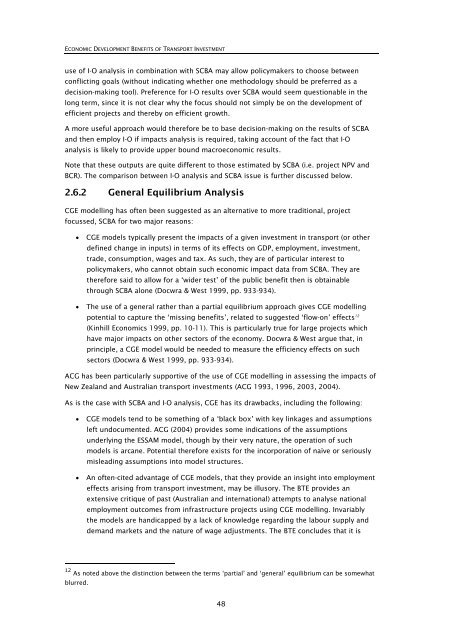Research 350 - NZ Transport Agency
Research 350 - NZ Transport Agency
Research 350 - NZ Transport Agency
Create successful ePaper yourself
Turn your PDF publications into a flip-book with our unique Google optimized e-Paper software.
ECONOMIC DEVELOPMENT BENEFITS OF TRANSPORT INVESTMENT<br />
use of I-O analysis in combination with SCBA may allow policymakers to choose between<br />
conflicting goals (without indicating whether one methodology should be preferred as a<br />
decision-making tool). Preference for I-O results over SCBA would seem questionable in the<br />
long term, since it is not clear why the focus should not simply be on the development of<br />
efficient projects and thereby on efficient growth.<br />
A more useful approach would therefore be to base decision-making on the results of SCBA<br />
and then employ I-O if impacts analysis is required, taking account of the fact that I-O<br />
analysis is likely to provide upper bound macroeconomic results.<br />
Note that these outputs are quite different to those estimated by SCBA (i.e. project NPV and<br />
BCR). The comparison between I-O analysis and SCBA issue is further discussed below.<br />
2.6.2 General Equilibrium Analysis<br />
CGE modelling has often been suggested as an alternative to more traditional, project<br />
focussed, SCBA for two major reasons:<br />
• CGE models typically present the impacts of a given investment in transport (or other<br />
defined change in inputs) in terms of its effects on GDP, employment, investment,<br />
trade, consumption, wages and tax. As such, they are of particular interest to<br />
policymakers, who cannot obtain such economic impact data from SCBA. They are<br />
therefore said to allow for a ‘wider test’ of the public benefit then is obtainable<br />
through SCBA alone (Docwra & West 1999, pp. 933-934).<br />
• The use of a general rather than a partial equilibrium approach gives CGE modelling<br />
potential to capture the ‘missing benefits’, related to suggested ‘flow-on’ effects 12<br />
(Kinhill Economics 1999, pp. 10-11). This is particularly true for large projects which<br />
have major impacts on other sectors of the economy. Docwra & West argue that, in<br />
principle, a CGE model would be needed to measure the efficiency effects on such<br />
sectors (Docwra & West 1999, pp. 933-934).<br />
ACG has been particularly supportive of the use of CGE modelling in assessing the impacts of<br />
New Zealand and Australian transport investments (ACG 1993, 1996, 2003, 2004).<br />
As is the case with SCBA and I-O analysis, CGE has its drawbacks, including the following:<br />
• CGE models tend to be something of a ‘black box’ with key linkages and assumptions<br />
left undocumented. ACG (2004) provides some indications of the assumptions<br />
underlying the ESSAM model, though by their very nature, the operation of such<br />
models is arcane. Potential therefore exists for the incorporation of naïve or seriously<br />
misleading assumptions into model structures.<br />
• An often-cited advantage of CGE models, that they provide an insight into employment<br />
effects arising from transport investment, may be illusory. The BTE provides an<br />
extensive critique of past (Australian and international) attempts to analyse national<br />
employment outcomes from infrastructure projects using CGE modelling. Invariably<br />
the models are handicapped by a lack of knowledge regarding the labour supply and<br />
demand markets and the nature of wage adjustments. The BTE concludes that it is<br />
12 As noted above the distinction between the terms ‘partial’ and ‘general’ equilibrium can be somewhat<br />
blurred.<br />
48
















